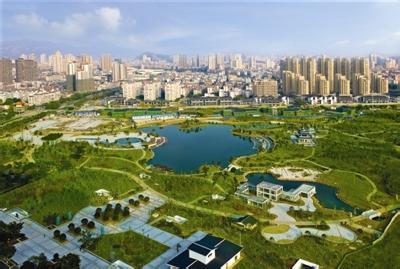Progress and Gaps on Low Carbon Actions for Chinese Cities
chinagate.cn by Yang Li, December 15, 2015 Adjust font size:

Cities represent the biggest share of China’s total energy consumption and energy-related CO2 emissions. They are hubs of economic activities and employment attracting inward migration from surrounding rural regions.
In 2014, 749.16 million people lived in urban area, accounting for 54.77% of total population. This explains why power and industrial activities are major sources of pollution in most cities. Buildings and transportation will also become potentially important emission-intensive sectors with the acceleration of urbanization.
The urbanization rate in 2020 is planned to reach 60%, representing almost an annual average growth rate of 1%, which inevitably will lead to a parallel annual increase in total energy consumption. Low carbon development of China’s cities will be critical to achieve the nation’s climate mitigation targets, therefore.
As municipal governments have central decision-making authority in local economic development and public services that will influence GHG emissions, how to adopt policies and actions on low carbon development into city administration is a significant challenge. To this end, the National Development and Reform Commission (NDRC) has launched a low-carbon pilot including six provinces and 36 cities to carry out practical activities and identify appropriate measures and patterns to be generalized to promote urban low-carbon development.
During the US-China Climate Leaders’ Summit this year, the Alliance of Peaking Pioneering Cities (APPC) was established to embrace nine cities - Guiyang, Beijing, Jilin, Wuhan, Shenzhen, Guangzhou, Zhenjiang, Jinchang and Yan’an - from the pilot 36 low carbon pilot cities.
They are committed to peaking carbon emissions earlier than China’s national goal and taking ambitious climate change actions to do so. In general, therefore, low carbon policies, programs and measures for Chinese cities have been preliminary established, and are generally characterized by:
1) Decoupling economic growth from CO2 emissions through economy structural shift to the low carbon sector, including increasing the share of tertiary industry in local GDP;
2) Developing a planning and management system for urban low carbon development, including targets for emission intensity and emission peaking, an action plan that includes a GHG emissions inventory and reporting module, and an advance carbon assessment for any new investment projects;
3) Upgrading the industrial structure and technology, including mandatory local industrial energy efficiency and low carbon industrial zone pilots;
4) Optimizing the energy consumption structure, including total energy consumption control, total coal consumption control, and increasing the share of renewable power and distributed generation resources;
5) Reducing energy consumption in buildings, including establishing standards and labelling for existing and new buildings codes and appliances, promotion of green buildings and an increased level of use of renewable energy in buildings;
6) Developing low carbon urban transport, including private vehicle use control, raising the share of public transport in motorized travel, promotion of walking and cycling for commuting and leisure, subsidies for electric vehicle and infrastructure construction of charging stations, and green freight transport.
7) Smart urban forms and urban boundary development, including integration of low carbon development into city master plans and land use plan, higher population density and mixed land use.
8) Promoting carbon sink and waste management projects, including increased coverage of urban forests and establishment of more green land, and a waste minimization system including waste reduction, recycling and reuse.
Based on an analysis of actions and policies taken in the nine APPC cities, it has become possible to achieve benchmarking of their low carbon actions against international best practices, and preliminary results suggest there is great room for improvement in the following areas:
1) Cities need develop integrated quantitative analysis to understand the carbon mitigation potential across sectors, which allows policymakers to prioritize actions based on cost effectiveness;
2) Peer learning and encouraging competition to reach the top mechanism level should be developed to disseminate best practices among cities;
3) Policies and standards in transportation, buildings and urban planning should be at least as strong as global leading practice, given the considerable challenge of maintaining current energy use levels while improving living standards;
4) Energy efficiency improvement has the biggest mitigation potential in the short term; however, it is also important to prepare the infrastructure for long term clean energy technology deployment;
5) Most importantly, a smart financing platform needs to be developed that introduces a new economic driving force for capturing carbon mitigation potential.
These are the most practical solutions as China enters a period of slower economic growth.
The author is a senior analyst of Innovative Green Development Program